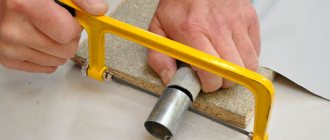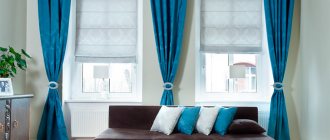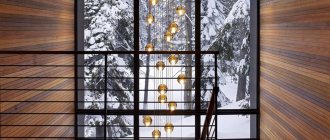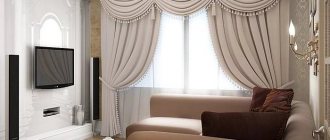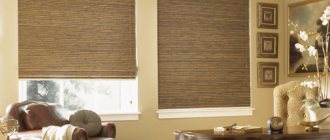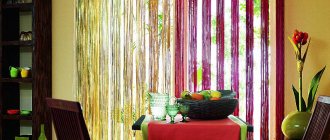Topics: # how to choose the right curtains # which curtains are better to choose # how to choose curtains for a window
When choosing curtains for windows, you usually first pay attention to the color and design, and then to the technical characteristics. We suggest first of all to deal with the technical side of the issue. Then you can immediately consider only suitable options and not waste time.
We have been developing and producing home textiles for 5 years. During this time, we have accumulated a decent amount of knowledge about what types of curtains there are and what properties they have. We also studied the requests and reviews of our customers, which helped us identify the main problems when choosing and using curtains. Based on all this, our selection guide was compiled.
We will not consider all types of curtains, but only those presented in our catalog - straight to the floor. Because we know reliably and comprehensively only about what we do ourselves. This type is also called classic, curtains and drapes. Typically they are placed in the bedroom, living room or hall, but sometimes they can be seen in the kitchen, balcony and other rooms in the house.
In the guide we will examine in detail the following questions:
- How to choose a size and what options do we have?
What comes first: cornice or curtain? How to take measurements and what should be taken into account? - How are our curtains attached?
About our fasteners and their installation methods. - What curtain materials do we use and why?
About synthetic bases and mixed fabrics. - What textures, types of fabric and patterns are there?
Our examples. About jacquard, blackout, embroidery and others
As a result, we will create a checklist for choosing curtains and our recommendations, which will help you quickly and confidently navigate the catalog. A checklist will be waiting for you at the end of the guide.
Types of curtain fastenings
There are several options for attaching curtain rods to the surface, and curtains to the cornices. By design, cornices can be wall or ceiling. In shape - round, square, rectangular and non-standard (rare). As for attaching curtains, it is worth deciding on the design in advance. You need to understand what it should be - massive or, conversely, lighter.
Compliance with certain recommendations plays an important role:
- fasteners must be selected at the stage of repair activities;
- an important role is played by the correspondence of curtains to the overall interior style;
- if there is a cornice, it should go well with the furniture designs in color;
- for fastening you can use tapes, loops, clips and rings;
- if we are talking about low ceilings, it is worth attaching curtains to the ceiling, this will make the interior visually more spacious;
- heavy materials are attached to structures of increased strength, for example, made of metal or certain types of wood;
- if the windows are narrow, they can be decorated with a semicircular cornice.
As for the options for attaching the curtains themselves, they can be as follows:
- to the cornice (this is a classic method that is found almost everywhere);
- without a cornice (this option also exists; in this case, the curtains are attached to the wall, frame or directly to the ceiling).
When it comes to location, here are the most common options:
- ceiling (this method is ideal for rooms characterized by low ceiling coverings; it will visually enlarge the room);
- wall (this option is classic and facilitates the installation of almost any available structure);
- window sash (traditionally used to secure blinds, sometimes for bamboo or roller blinds);
- frame (this design looks perfect with miniature curtains).
If we are talking about curtains that are mounted on a cornice, you can consider the following types of fastenings:
- drawstring (a special pocket designed for curtains, through which a pipe or cornice easily passes);
- Velcro (used in situations where static fastening of curtains to the mount is required);
- eyelets (these are rings sewn into the fabric, the method is reliable and has a pleasant appearance);
- rings (this is a classic of the genre, which involves the use of rings and small clips);
- hinges (a practical method, characterized by convenience, looks good in the kitchen);
- magnets (easily and tightly clamped between the latches);
- braid (this is a whole row of loops, with which you can easily adjust the length of the structure and the depth of the wave);
- tape (the product is universal and ideal for attaching curtains);
- hooks (this option is affordable and simple);
- ties (they can be made in-house and are an interesting decorative element).
If we are talking about mounting without a cornice, it is worth taking into account the following options:
- universal-purpose brackets (they are convenient because they take up little space and are used to secure blinds);
- Velcro is suitable for rooms that do not require a lot of sunlight;
- self-tapping screws are inexpensive, and finding them is not difficult;
- double-sided tape (the method is not reliable, but it will do if you don’t have any other materials at hand).
Features of window design with tulle
If you gather the tulle into beautiful waves, then it will all look luxurious and relaxed. Previously, folds were created independently. But now there is a special tape for tulle that will create smooth waves quickly and effectively.
Light curtains are made from translucent materials and do not shade the window too much.
This ribbon looks like a strip of lightweight material with laces. If you sew the ribbon to the tulle and tighten the thread, the waves will be smooth and beautiful. You can attach it thanks to textile loops, which in turn are sold with hooks.
For tulle it is better to choose a transparent ribbon. On light fabrics, such as organza or mesh, it will be invisible. Curtains and thick materials look better and are held on strong fasteners.
Colored curtains will create a bright accent and add variety to the interior.
Note! Durable fabric is made from natural material - cotton. Buy more tape than you need so that after washing it can shrink by 10-15 percent of the original size. You can also steam it before sewing.
There are different types of tapes that create a custom fit.
- Uniform waves. After you tighten the lace, the fold will be a straight pencil.
- Boof. This wave is also called a waffle, because it is very similar to sweetness.
- Glass or shot glass. The relief resembles an interesting goblet-shaped wave.
- Bow. Equal wave bows are produced on the material. It is impossible to do this without tape and experience.
- Goose feet. Triple and uniform wave on the fabric.
Light tulle can replace the usual thick curtains.
In the kitchen
It is recommended to choose a simple translucent tulle for the kitchen. Available in a single color with a small ornament. The main thing is that the chosen product gives comfort and peace of mind. Prepare veil, organza, and smoky mesh. It is necessary that the fabric does not deteriorate from the color of the sun and does not get too dirty.
Classic curtains with floral patterns are also allowed in the kitchen.
In the children's room
The children's room is filled with bright and bold colors. The tone of the tulle is selected to suit the child’s tastes, so you don’t have to be limited. Pastel colors, white tulle, large patterns and lush bows will decorate the room. If the child is small, then it is best to choose a short curtain so that the baby does not tear it and gets less dirty. For older children, curtains can create a real kingdom.
3D curtains with images of cartoon characters are perfect for a child's room.
In the bedroom
For the bedroom the range is quite wide. Manufacturers offer many options for colors, shapes and designs. A veil, light organza, viscose and tulle will fit perfectly.
Beige curtains will suit a green bedroom.
In the living room
For the living room, it is recommended to use light translucent tulle, which allows light and air to pass through well. It can be combined with a curtain, lambrequin, drapery, embroidery and lace. Multilayer products in different shades are considered relevant.
For textured wallpaper, brighter curtains with the same texture are selected.
In the hall
If the curtain will be the main element in the room, then choose a rich and bright fabric. If this is an addition, then buy an inconspicuous light canvas. Consider the overall design of the room. If you prefer the classics, then lambrequins, flounces and tiebacks will fit perfectly. If you want to adhere to minimalism, then pay attention to texture and color. Almost any tulle is suitable for the hall, the main thing is that it matches the overall picture.
Curtains should not blend in with the wallpaper.
How to determine the width of curtains
You can get the most accurate measurements by using a tape measure rather than a measuring tape. To correctly determine the basic indicators, it is worth taking into account three values at once:
- the length that the cornice has;
- coefficient value of material assembly (splendor);
- allowance of centimeters.
It should be noted that the cornice, which is installed correctly, must have an additional length from each side of the window opening, and it is equal to 20-25 cm. Due to this installation, you can move the curtains apart and ensure that a sufficient amount of sunlight penetrates into the room.
By the way! If the window is too narrow, it can be visually expanded using curtains that cover not only the window opening, but also part of the walls. All this should be taken into account when measuring the length of the fastening system.
The calculation scheme for curtains based on their width is presented as follows:
- first, the working distance of the rod is measured, namely the rail, the string along which the curtains will move;
- Next, you need to determine the degree of splendor, which depends on the level of density of the material and its texture (curtains look most beautiful when they do not hang flat, but have beautiful folds);
- if we are talking about materials such as organza, tulle, veil, the coefficient value of the assembly is 2-4, that is, the width of the curtains will exceed the working length of the cornice by 2-4 times;
- if the fabrics are denser, for example, linen, satin, silk, chintz, the coefficient is 2-2.5 units;
- if the curtains have an extremely high density (taffeta, jacquard, velvet), the parameter is 1.5-2.
Designers do not recommend choosing a large number of folds. To the result obtained, another 5-7 cm is usually added for overlap. The general formula for calculations traditionally looks like this:
Length of the cornice = Number of curtains * Ruffle factor + 5 cm additional = Width of one finished curtain.
For example, if the cornice is 3.5 m long and the build factor is 2, the calculation will look like this:
(3.5 / 2) * 2 + 0.05 = 3.55 m - this is exactly the width of one curtain (finished product).
Since we are talking about an already made curtain, you need to add another 2-2.5 cm on the sides for processing.
curtains
Build factor
The gathering factor (GC) is a value that helps determine how much fabric needs to be gathered across the width. Essentially, this is the allowance for the waves and tails, and it determines how magnificent they will be in the end.
The gathering factor depends on the type of folds formed on the curtain fabric
Before you calculate the width of the tulle for the window, you need to find out what the KS will be. To do this you need to know two quantities:
The width of the footage is calculated using a simple formula:
Amount of fabric = k x curtain rod length
Where k is the assembly (filling) coefficient. For different types of assembly that the braid forms, it will be different:
- Pencil – k = 2.5-3.
- Buffs – k = 1.5 – 2.5.
- “Crow's feet” – k = 2.
- Goblet-shaped, bow-shaped – k = 2.5-3.
Note! The KS must be indicated on the packaging of the curtain tape. Typically the average ratio is 1:2.5. It is suitable for almost any curtain design.
Knowing the CS, all that remains is to calculate the required amount of tissue. If, for example, k = 1.5, and the length of the cornice is 275 cm, then to sew curtains you will need to collect 375 cm (3.75 meters) of fabric (1.5 x 250 cm = 375 cm).
Important. When calculating, it is necessary to add allowances for the side seams. As a rule, add 6 cm, 3 cm for each side seam.
Processing the side cut of the curtain
In our example, to the width of 3.75 m, you also need to add 6 cm for the side seams. The total width of the fabric will be 3 m 81 cm.
Deciding on the length of the curtains
The length of the curtain is usually understood as the distance from the rod to the level that was selected. This parameter is determined in accordance with the style of the interior and the individual preferences of the owners. Curtains can be floor-length and even lay in a train, and can also be located in the window sill area. Along with this, the method of processing the upper edge is taken into account.
It should also be understood that over time, curtains require washing, especially those made from natural materials. After all, they have the ability to “sit down,” that is, to decrease in size. And this figure can reach 10%, even more. To avoid unpleasant consequences, you need to think about the shrinkage allowance, namely, add 5-8 cm to “be on the safe side.”
What curtains will go with gray wallpaper?
Decorating the walls in gray tones adds elegance to the room. The right combination with them helps to create a chic environment that evokes admiration. All shades of red, yellow and orange will go well with gray. They will enliven the interior and dilute the cold gray, adding warmth.
By choosing blue and green tones, you can visually enlarge the room. The white color of the curtains will bring lightness to it. The priority is soft tones of gray; they will add some sophistication to the design and make it unique.
Useful tips
If we talk about the width of a roll of light fabrics, it is 2.8 m. This is especially true for veils, organza, and tulle. If the height corresponds to these figures, it will not be difficult to determine the final number of linear meters. As for curtain fabrics, the situation with them is more serious, because rolls can have different widths - from 1 m 40 cm to 3 m.
And if the width of the roll is less than the length of the curtain, you will have to stitch it together from several fabric sheets, which is more expensive in terms of money. The build factor will also play an important role, as will the pattern on the material. If the canvas is connected to each other, the pattern must match, which will require the use of additional centimeters.
As already noted, technique for measuring the length and width of curtains plays an important role, as well as taking into account additional meters that may be needed to create folds and trims. It is worth measuring the parameters using a centimeter or a regular ruler, and this should be done several times to avoid mistakes. Of course, it is worth taking into account the consumption of fabric for additional decorations - bows, lambrequins, ruffles, etc.
Thus, calculating curtains for a window can be quite simple; for this you need to follow special instructions and take into account some of the most important points. Achieving such a result will not be difficult, especially if you act competently and consistently. And you can cope with this using the materials given in the article.
Carrying out measurements and calculations
In order to create the perfect decoration, you need to know how to calculate the tulle for the window.
To measure the window opening, it is better to use a steel construction tape. With its help you will carry out calculations accurately. Also consider the height of the cornice and the presence of rings that attach the material. It is best to attach the curtain in advance in order to correctly calculate the length and not make a mistake with the size of the fabric.
It is better to take measurements not with a centimeter tape, but with a steel construction tape. Thanks to its density, calculations will be carried out more accurately, and the error will be minimized.
Write down all the numbers so as not to make mistakes in the formula. Measure the length of the cornice, the height of the window, taking into account the method of fastening.
A special curtain tape will easily help you attach the tulle to the cornice. Attachment is also possible thanks to loops, eyelets, pencil waves, triple pleats and buffers.
It is advisable that the cornice be attached to the wall before calculating the footage of the required canvas.
Examples of different collection ratios
In addition to the tape, there are several other options for designing window textiles when sewing. When choosing one of them, it is also important to consider the CS.
- On the eyelets. The fabric sheet is strung on a bar using special metal or plastic rings installed along the upper edge. This option is often used for draping balcony windows. Curtains on the eyelets do not interfere with opening the door, since they can be easily moved to the side with one movement. For curtains with grommets, it is better to choose k=2.
Eyelets on thin tulle are secured using thick curtain tape
Tulle curtain with double ruffle hinges
Before you put fabric on window curtains, curtains or drapes, you need to decide on the fill factor, type of braid, textile design features and accurately measure the length of the cornice. Knowing these parameters, sewing beautiful window textiles will not be difficult. Examples of photos of window curtains with different frames will help you choose the right option that the whole family will like.

